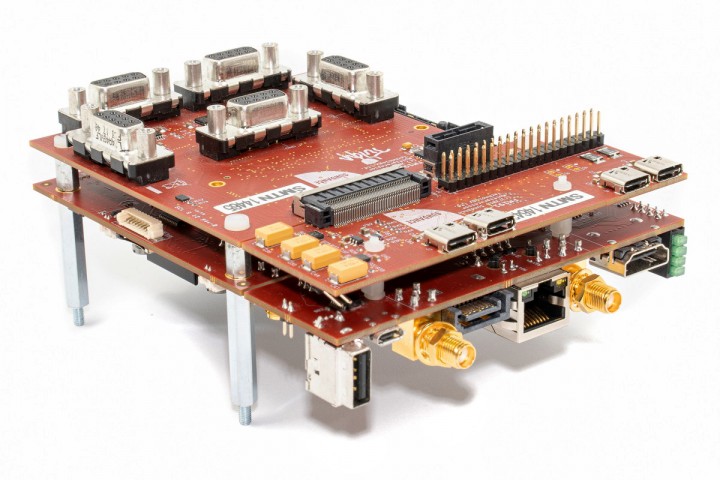The VCS-1 is a PC/104 Linux stack composed of 2 main components, namely the EMC2 board which is a PCIe/104 OneBank™ carrier for a Trenz compatible SoC Module and the FM191 expansion card that fans out the I/Os from the SoC to the outside world.
The SoC provides standard connectivity (e.g. SPI, RS232, I2C, USB, GigE, PCIe, etc), ARM-based processing which is used to run Ubuntu Linux OS and ROS Melodic, memory interfaces and Programmable Logic used for Hardware acceleration and GPIO. The SoC can either be Xilinx Zynq 7 Series (Dual Core ARM Cortex A9) or Xilinx MPSoC Zynq Ultrascale+ (Quad Core ARM Cortex A53).
VCS-1 overview page in our online shop (ZU4EV and ZU2CG available)
Press release
http://www.humbugpr.com/8.html
Documentation
- VCS-1 GitHub Repository
- EMC2-DP Open Source Hardware Repository
- Deliverable 2.1c – Construction and assembly of the electronic systems
Video Demonstration
Features
Utilizing the PC/104 form factor, which measures just 90mm x 96mm, to provide industry-standard compatibility and expandability, the Sundance VCS-1 embedded processor module is optimized for computer vision, Edge AI and Deep Learning requirements. It weighs just 300g, has a low power consumption of typically 15W and is highly compatible with a wide range of commercially available sensors and actuators.
At the processing heart of the Sundance VCS-1 is a Xilinx Zynq UltraScale+ MPSoC which is mounted on to the PC/104 board using a System-on-Module (SoM). It incorporates an ARM Cortex A53 64-bit quad-core processor combining real-time control through engines for graphics, video, waveform, and acceleration with an FPGA. These include an ARM Mali 400 graphics processing unit (GPU) for graphics acceleration, an ARM Cortex R5 Real-Time Processing Unit (RPU) for managing real-time events and the programmable FPGA logic for hardware acceleration of AI algorithms used for on-the-fly image processing.
The Sundance VCS-1 features extensive I/O capabilities made available through the Sundance External Interface Card (SEIC), including multiple USB3 interfaces for interfacing various cameras and sensors such as the Intel RealSense T265 tracking camera, Intel RealSense D435 and Stereo Labs Zed depth cameras and FLIR AX-8 thermal camera. It can also connect with most Arduino and Raspberry Pi actuators and sensors. A further interface enables it to mimic PC with HDMI display, SATA storage and Ethernet networking. An onboard ADC is available to gather data from an external sensor and there is an onboard DAC to control servos etc. A large selection of I/O standards is also implemented directly on the programmable logic to reduce the latency between the various supported cameras, sensors and servos.
Extensive software support is provided for precision robotics solutions including the ROS Melodic Morenia (ROS compatible and ROS2 ready) robotics platform, MQTT machine-to-machine connectivity protocol, OpenCV computer vision library of real-time programming functions, the Xilinx’s Edge-AI solutions and the Python scripting language. Also supported are the Ubuntu operating system, Xilinx SDSoC environment, TULIPP’s STHEM toolchain and Xilinx DPU (deep learning processing unit) for convolutional neural networks.
Hardware Compatible
- Raspberry PI and Arduino compatible
- Compatible with most of the Arduino/RPI sensors and actuators
- 4x USB3.0 ports for interfacing with a wide range of sensors
- MQTT and OpenCV compatible
- ROS compatible
- ROS2 ready
Additional Information
Package Content
- 1 x EMC2-ZU4-EV PC/104 Platform with Zynq ZU4/EV
- 1 x FM191-RUA1 Quad USB3 + ADC/DAC FMC I/O add-on
- 1 x OPUS DCX2.240 DC/DC PSU, 240W, 24VDC In, ATX Out, Boxed
- 1 x DPS-120AB-3 AC/DC Desktop PSU - 24VDC @ 120W Out
- 1 x Lynsyn Monitor Power Measurement Board
- 1 x JTAG-HS3 Cable JTAG Debugger for Zynq PL/SDSoC + ARM
- 1 x Xilinx SDSoC-Zynq Development voucher

